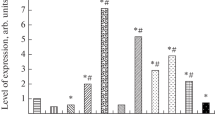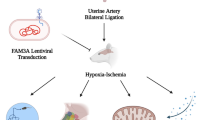Abstract
Intrauterine hypoxia is one of the most common stressors in fetuses, which can lead to abnormal brain development and permanent neurological deficits in adulthood. Neurological disorder excitotoxicity induced by hypoxia or ischemia may involve N-methyl-d-aspartate receptors (NMDARs), which are known to participate in the maturation and plasticity of developmental neurons. Inhibition of NMDARs has been reported to improve neurological outcomes in traumatic brain injuries and Alzheimer’s disease. Here, we investigated if antenatal blockade of NMDARs induced by memantine could alleviate neurodevelopmental brain damage and long-term cognitive deficits in intrauterine hypoxia rats. Pregnant rats were assigned to four groups: air control, air + memantine, hypoxia, and hypoxia + memantine. The rats were exposed to hypoxic conditions (FiO2 = 0.095–0.115) for 8 h/day (hypoxia group) or given a daily memantine injection (5 mg/kg, i.p.) before hypoxia exposure from pregnant day 19 (G19) to G20 (hypoxia + memantine group).The influence of NMDARs antenatal blockade by memantine on intrauterine hypoxia-induced brain developmental damage and cognitive function was then studied. Intrauterine hypoxia resulted in decreased fetal body weight, brain weight, cognitive function, hippocampal neuron numbers, and Ki-67 proliferation index in the hippocampus. Memantine preventive treatment in pregnant rats before hypoxia exposure alleviated the aforementioned damage in vivo. Excessive activation of NMDARs contributes to fetal brain developmental damage and cognitive ability impairment induced by intrauterine hypoxia, which could be alleviated by antenatal memantine preventative treatment.








Similar content being viewed by others
References
Miller SL, Huppi PS, Mallard C (2015) The consequences of fetal growth restriction on brain structure and neurodevelopmental outcome. J Physiol 594(4):807
Volpe JJ (2001) Neurobiology of periventricular leukomalacia in the premature infant. Pediatr Res 50(5):553–562
Mach M, Dubovický M, Navarová J, Brucknerová I, Ujházy E (2009) Experimental modeling of hypoxia in pregnancy and early postnatal life. Interdiscip Toxicol 2(1):28
Sombati S, Coulter DA, Delorenzo RJ (1991) Neurotoxic activation of glutamate receptors induces an extended neuronal depolarization in cultured hippocampal neurons. Brain Res 566(1–2):316
Lipton SA, Rosenberg PA (1994) Excitatory amino acids as a final common pathway for neurologic disorders. N Engl J Med 330(9):613
Yue S (1994) The excitatory neurotoxicity of glutamic and the central nervous system injury. Foreign Med Sci Sect Neurol Neurosurg 4:205–208
Waters KA, Machaalani R (2004) NMDA receptors in the developing brain and effects of noxious insults. Neuro-Signals 13(4):162–174. https://doi.org/10.1159/000077523
Ritter LM, Unis AS, Meador-Woodruff JH (2001) Ontogeny of ionotropic glutamate receptor expression in human fetal brain. Dev Brain Res 127(2):123–133
Elizabeth GPD, Cameron HA, Mcewen BS (1994) Blockade of NMDA receptors increases cell death and birth in the developing rat dentate gyrus. J Comp Neurol 340(4):551
Gould E, Cameron HA (1997) Early NMDA receptor blockade impairs defensive behavior and increases cell proliferation in the dentate gyrus of developing rats. Behav Neurosci 111(1):49
Komuro H, Rakic P (1993) Modulation of neuronal migration by NMDA receptors. Science 260(5104):95
Rakic P (1998) Images in neuroscience. Brain development, VI: radial migration and cortical evolution. Am J Psychiatry 155(9):1150–1151
Bear MF, Cooper LN, Ebner FF (1987) A physiological basis for a theory of synapse modification. Science 237(4810):42–48
Brooks WJ, Petit TL, Leboutillier JC, Lo R (1991) Rapid alteration of synaptic number and postsynaptic thickening length by NMDA: an electron microscopic study in the occipital cortex of postnatal rats. Synapse 8(1):41
Mcdonald JW, Silverstein FS, Johnston MV (1988) Neurotoxicity of N-methyl-D-aspartate is markedly enhanced in developing rat central nervous system. Brain Res 459(1):200–203
Balázs R, Hack N, Jørgensen OS (1990) Interactive effects involving different classes of excitatory amino acid receptors and the survival of cerebellar granule cells in culture. Int J Dev Neurosci 8(4):347
Bonfoco E, Krainc D, Ankarcrona M, Nicotera P, Lipton SA (1995) Apoptosis and necrosis: two distinct events induced, respectively, by mild and intense insults with N-methyl-D-aspartate or nitric oxide/superoxide in cortical cell cultures. Proc Natl Acad Sci USA 92(16):7162–7166
Herlenius E, Lagercrantz H (2001) Neurotransmitters and neuromodulators during early human development. Early Hum Dev 65(1):21–37
Myseros JS, Bullock R (1995) The rationale for glutamate antagonists in the treatment of traumatic brain injury. Ann N Y Acad Sci 765(1):262–271
Chen H, Liu Z, Zhou Z, Jiang M, Qian L, Wu S (2003) The regulatory effect of memantine on expression and synthesis of heat shock protein 70 gene in neonatal rat models with cerebral hypoxic ischemia. Chin Med J 116(4):558–564
Rao VL, Dogan A, Todd KG, Bowen KK, Dempsey RJ (2001) Neuroprotection by memantine, a non-competitive NMDA receptor antagonist after traumatic brain injury in rats. Brain Res 911(1):96
Gao Y, Chen HJ, Qian LH, Chen GY (2006) Long-term effects of memantine therapy on neonatal rats with hypoxic-ischemic brain damage. Chin J Contemp Pediatr 8(1):38
Heidrich A, Rösler M, Riederer P (1997) Pharmacotherapy of Alzheimer dementia: therapy of cognitive symptoms-new results of clinical studies. Fortschr Neurol Psychiatr 65(3):108
Parsons CG, Danysz W, Quack G (1999) Memantine is a clinically well tolerated N-methyl-D-aspartate (NMDA) receptor antagonist—a review of preclinical data. Neuropharmacology 38(6):735
Liao Z, Zhou X, Luo Z, Huo H, Wang M, Yu X, Cao C, Ding Y, Xiong Z, Yue S (2016) N-methyl-D-aspartate receptor excessive activation inhibited fetal rat lung development in vivo and in vitro. Biomed Res Int 2016(5):5843981
Kalynchuk LE, Pinel JP, Treit D, Barnes SJ, Mceachern JC, Kippin TE (1998) Persistence of the interictal emotionality produced by long-term amygdala kindling in rats. Neuroscience 85(4):1311–1319
Albert DJ, Richmond SE (1975) Septal hyperreactivity: a comparison of lesions within and adjacent to the septum. Physiol Behav 15(3):339–347
Morris R (1984) Developments of a water-maze procedure for studying spatial learning in the rat. J Neurosci Methods 11(1):47–60
Lubics A, Reglodi DA, Kiss P, Szalai M, Szalontay L, Lengvari I (2005) Neurological reflexes and early motor behavior in rats subjected to neonatal hypoxic-ischemic injury. Behav Brain Res 157(1):157–165
Aboutaleb N, Kalalianmoghaddam H, Eftekhari S, Shahbazi A, Abbaspour H, Khaksari M (2014) Apelin-13 inhibits apoptosis of cortical neurons following brain ischemic reperfusion injury in a transient model of focal cerebral ischemia. Int J Pept Res Ther 20(2):127–132
Gheibi S, Aboutaleb N, Khaksari M, Kalalian-Moghaddam H, Vakili A, Asadi Y, Mehrjerdi FZ, Gheibi A (2014) Hydrogen sulfide protects the brain against ischemic reperfusion injury in a transient model of focal cerebral ischemia. J Mol Neurosci 54(2):264–270
Kee N, Sivalingam S, Boonstra R, Wojtowicz JM (2002) The utility of Ki-67 and BrdU as proliferative markers of adult neurogenesis. J Neurosci Methods 115(1):97–105
Jang EA, Longo LD, Goyal R (2015) Antenatal maternal hypoxia: criterion for fetal growth restriction in rodents. Front Physiol 6:176
Golan H, Kashtuzki I, Hallak M, Sorokin Y, Huleihel M (2004) Maternal hypoxia during pregnancy induces fetal neurodevelopmental brain damage: partial protection by magnesium sulfate. J Neurosci Res 78(3):430–441
Golan H, Kashtutsky I, Hallak M, Sorokin Y, Huleihel M (2004) Maternal hypoxia during pregnancy delays the development of motor reflexes in newborn mice. Dev Neurosci 26(1):24
Stocker CJ, Arch JRS, Cawthorne MA (2005) Fetal origins of insulin resistance and obesity. Proc Nutr Soc 64(2):143–151
Ojeda NB, Grigore D, Alexander BT (2008) Intrauterine growth restriction: fetal programming of hypertension and kidney disease. Adv Chronic Kidney Dis 15(2):101–106
Murray E, Fernandes M, Fazel M, Kennedy SH, Villar J, Stein A (2015) Differential effect of intrauterine growth restriction on childhood neurodevelopment: a systematic review. BJOG Int J Obstet Gynaecol 122(8):1062
Forsén T, Eriksson J, Tuomilehto J, Reunanen A, Osmond C, Barker D (2000) The fetal and childhood growth of persons who develop type 2 diabetes. Ann Intern Med 133(3):176
Barker DJ, Osmond C, Forsén TJ, Kajantie E, Eriksson JG (2005) Trajectories of growth among children who have coronary events as adults. N Engl J Med 353(17):1802–1809
Dulloo AG (2008) Thrifty energy metabolism in catch-up growth trajectories to insulin and leptin resistance. Best Pract Res Clin Endocrinol Metab 22(1):155–171
Bromleybrits K, Deng Y, Song W (2011) Morris water maze test for learning and memory deficits in Alzheimer’s disease model mice. J Vis Exp JoVE 53:e2920–e2920
Mcnamara RK, Skelton RW (1993) The neuropharmacological and neurochemical basis of place learning in the Morris water maze. Brain Res Rev 18(1):33–49
Jeffery KJ, Morris RG (1993) Cumulative long-term potentiation in the rat dentate gyrus correlates with, but does not modify, performance in the water maze. Hippocampus 3(2):133
Morris RGM, Anderson E, Lynch GS, Baudry M (1986) Selective impairment of learning and blockade of long-term potentiation by an N-methyl-D-aspartate receptor antagonist, AP5. Nature 319(6056):774–776
Khalaf-Nazzal R, Francis F (2013) Hippocampal development—old and new findings. Neuroscience 248C(38):225
Lüscher C, Malenka RC (2012) NMDA receptor-dependent long-term potentiation and long-term depression (LTP/LTD). Cold Spring Harb Perspect Biol 4(6):997–1001
Burd I, Welling J, Kannan G, Johnston MV (2016) Chapter five—excitotoxicity as a common mechanism for fetal neuronal injury with hypoxia and intrauterine inflammation. Adv Pharmacol 76:85–101
Chen HS, Wang YF, Rayudu PV, Edgecomb P, Neill JC, Segal MM, Lipton SA, Jensen FE (1998) Neuroprotective concentrations of the N-methyl-D-aspartate open-channel blocker memantine are effective without cytoplasmic vacuolation following post-ischemic administration and do not block maze learning or long-term potentiation. Neuroscience 86(4):1121–1132
Portera-Cailliau C, Price DL, Martin LJ (2015) Excitotoxic neuronal death in the immature brain is an apoptosis-necrosis morphological continuum. J Comp Neurol 378(1):10–87
Lipton SA, Nakanishi N (1999) Shakespeare in love-with NMDA receptors? Nat Med 5(3):270–271
Acknowledgements
The authors acknowledge all colleagues of the Department of Physiology, Xiangya Medical College, Central South University for technical assistance.
Funding
Funding was provided by National Science Foundation of China (Grant No. 81270121).
Author information
Authors and Affiliations
Corresponding author
Ethics declarations
Conflict of interest
The authors declare that they have no competing interest.
Rights and permissions
About this article
Cite this article
Li, T., Luo, Z., Liu, Y. et al. Excessive Activation of NMDA Receptors Induced Neurodevelopmental Brain Damage and Cognitive Deficits in Rats Exposed to Intrauterine Hypoxia. Neurochem Res 43, 566–580 (2018). https://doi.org/10.1007/s11064-017-2451-1
Received:
Revised:
Accepted:
Published:
Issue Date:
DOI: https://doi.org/10.1007/s11064-017-2451-1




